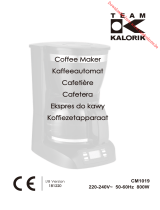EN
7
EN
6
• Do not unplug the appliance by pulling on the power supply cord.
• Do not put water into the appliance if it is still hot.• Always close the lid (A) when
the coffee maker is in operation.
• All appliances are subjected to quality control testing. Practical use tests are
conducted with appliances taken on a random basis, which explains any signs of
use.
• Never put your jug on the hob of a cooker.
• Do not use the jug without the lid.
• After starting your coffee maker, never put your hand on the warming plate
when you remove the jug from the coffee maker. During operation, this plate is
very hot and can cause burns.
• Your machine is designed only for domestic use. Any commercial use,
inappropriate use or failure to comply with the instructions, the manufacturer
accepts no responsibility and the guarantee will not apply. It is not designed to
be used in the following cases, which are not covered by the warranty:
- In staff kitchenettes, shops, offices and other professional environments
- In farms
- By customers in hotels, motels and other residential environments
- In environments such as bed and breakfast.
Before first use
• Plug the coffee maker into a mains socket with the same voltage as that
indicated on the rating plate of the appliance.
• Run the coffee make for the first time without coffee with 1 litre of water to rinse
the circuit.
Making coffee
(Follow the illustrations 1 to 5)
• Fill the tank with cold water.
• Use only cold water and a paper filter no. 4.
• Do not go over the maximum quantity of water shown on the tank water gauge.
• Close the lid of the filter holder before starting your coffee maker to avoid the risk
of hot water flowing on to the work surface.
• Place the jug on the warming plate.
• If you want to serve a cup of coffee before the end of the cycle, just remove the
jug from the warming plate. The coffee will stop flowing automatically. Return
the jug to the warming plate quickly so that the coffee may continue flowing.
• At the end of a cycle, wait for around one minute until the water in the filter
stops flowing into the jug. We recommend leaving the lid on the jug so that it is
easier to use and so that the coffee stays at the right temperature for longer.
• Turn off the switch when the jug is empty or when the appliance is not in use.
• If you want to make another coffee, turn off the appliance and wait for 10
minutes for the heating elements to cool down.
• You can re-heat your coffee by putting the jug into the microwave oven.
Important:
if you do not let the appliance cool down before preparing another coffee, the
water in the tank may become too hot and a jet of steam may come out, causing
burns.
Operation
• Press the switch; the red indicator light comes on and the coffee maker begins to
run.
• Lower the switch to stop the appliance.
Cleaning
• Unplug the appliance.
•To dispose of the used coffee grounds, remove the filter holder (B) from the
coffee maker by lifting the handle (Fig. 6 to 7).
• Do not clean the appliance while hot.
• Clean with a damp cloth or sponge.
• Never put the appliance in water or under running water.
• The filter holder and the jug can be washed in the dishwasher.
• Refit the removable filter holder correctly so that the lid closes properly. To do so,
press the filter holder slightly to flatten it on either side before lowering the
handle (Fig. 8 to 11).
Descaling
• Descale your coffee maker after every 40 cycles. You can use:
- a packet of limescale remover diluted in 2 large cups of water.
- or 2 large cups of white vinegar available from a hardware store.
• Pour the mixture into the tank (D) and switch the coffee maker on (without
coffee).
• Let the equivalent of one cup flow into the jug (E), then stop.
• Leave to work for one hour.
• Switch the coffee maker back on to run the rest of the descaling solution through.
• Rinse the coffee maker by running it 2 or 3 times with 1 litre of water.
The guarantee does not cover coffee makers that do not work properly or do not
work at all because they have not been descaled.



